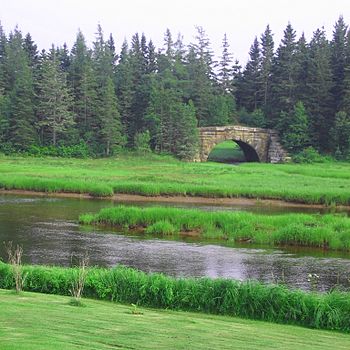Tidnish River facts for kids
Quick facts for kids Tidnish River |
|
|---|---|

Tidnish River near arch bridge for the defunct Chignecto Ship Railway.
|
|
| Country | Canada |
| Physical characteristics | |
| River mouth | Northumberland Strait sea level |
The Tidnish River is a small river in Canada. It flows along the border between two provinces: New Brunswick and Nova Scotia. This area is called the Isthmus of Chignecto, which is a narrow strip of land connecting Nova Scotia to the rest of North America.
Contents
Where the Tidnish River Flows
The Tidnish River starts in the northwest part of Cumberland County, Nova Scotia. This is just east of the border with New Brunswick. As it flows, other smaller streams join it. These are called its tributaries. The biggest ones are the West Branch Tidnish River, Little West Branch Tidneish River, Paradise Brook, and Chapman's Brook.
River's Journey to the Sea
The river eventually reaches a place called Tidnish Bridge. Here, the river becomes a tidal estuary. This means that the ocean's tides affect the river's water level. The water here is a mix of fresh river water and salty ocean water.
At Tidnish Bridge, you can see a large stone bridge. This bridge was built a long time ago for something called the Chignecto Ship Railway. This was a special railway designed to carry ships over land! From Tidnish Bridge, the river twists and turns for about 2 kilometers. It then flows into the Northumberland Strait at a spot called Jacksons Point. This area is part of a larger bay known as Baie Verte.
The Border River
The part of the river that flows downstream from Tidnish Bridge also forms part of the border between New Brunswick and Nova Scotia. This section of the river is a safe place for boats to dock. During high tide, smaller boats can even travel further up the river, past the old Chignecto bridge.
Fishing on the Tidnish River
The mouth of the Tidnish River is known for fishing, especially for a type of fish called smelt. While not as busy as it once was, some fishermen still catch smelt here. They often use large nets, about 28 feet wide, to catch the fish as the tide moves. In winter, they might even cut holes in the ice to set their nets.
You won't usually see boats that catch lobsters coming from the Tidnish River. However, sometimes boats that fish for herring or mackerel might be seen in the area.

